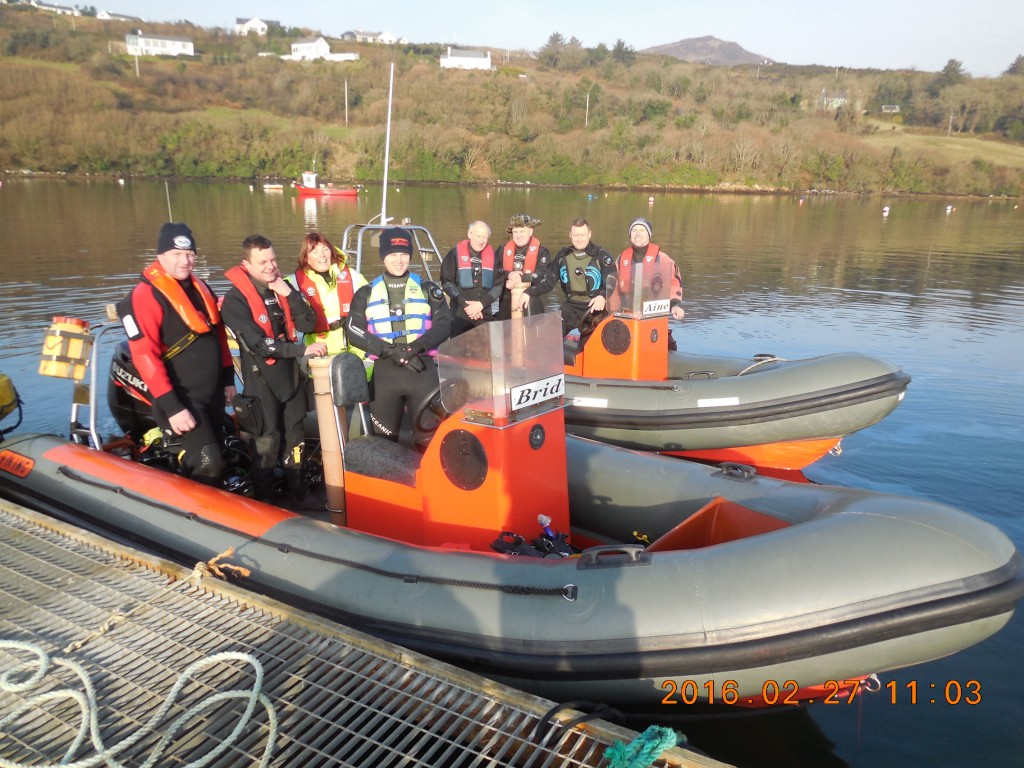SHEEPHAVEN SUB AQUA CLUB NOTES
Sheephaven divers had a couple of beautiful days last week with slack winds and bright sunshine, just made for getting into the water.
However diving activities started off on Wednesday evening’s with trainee pool work, which saw this year’s intake get their first experience of scuba training, in the comfort and safety of the Mevagh Dive Centre 3m pool.
Under the direction and guidance of Sheephaven SAC’s Training Officer, Anne Boyle, the trainees went through the full range of scuba skills, including water entry, buoyancy control, mask clearance, buddy breathing and the ultimate ditch and recovery of gear.
Saturday morning’s was a two boat dive party to Rossnakill Bay, which lies just off Mucross Channel between North and Broad Water in the Mulroy Bay system.
The dives were conducted in two sticks to a depth of 27 metres, experiencing a diverse ecosystem substrate that ranged from a coarse sandy seabed in the middle of the channel to boulders and rock wall closer to the surface.
Water temperature at around 4 degrees Celsius was as cold as Sheephaven divers have experienced all winter, but it didn’t deter a 40 minute dive in good water visibility of over 5 metres horizontally.
Marine life on site has begun to stir into spring mode, with the larger Sea Slugs starting to lay egg strings, which is heartening to see.
Also on this site there were examples of our only hard corals, the Devonshire Cup Coral, no bigger than a finger nail but a further testament to the quality of the water at this location.
Previous dives at this location produced examples of the rare Flame Shell Mussel, which lie just under the gravel seabed. They have a vivid red fringe around outside of the shell, hence their name.
Sunday morning’s snorkel was once again a well-attended affair from PortnaBlagh Pier, with a few new attendees taking full advantage of the calm sea conditions and the bright sunshine.
For some of the divers it was a chance to complete their annual water fitness test, joining the rest of the Clubs’ dived up members just ready to begin their 2016 diving.
With the 100th anniversary of the Battle of Jutland due on the May 2016 there is a Donegal connection to the biggest naval battle to have ever taken place in WW1 and the sinking of HMS Curacoa in WW2.
The only remaining warship from the day the British Grand Fleet met the German High Sea’s Fleet in the North Sea has recently been restored at a cost of £12m. HMS Caroline survived a battle that saw the British lose 14 ships and 6,000 men compared to German losses of 11 ships and 2,500 men. Of the 6,000 British sailors lost 350 were Irish.
In terms of losses the Royal Navy was beaten on the day, but the German Grand Fleet never put to sea again, except to surrender at the end of the war and subsequently be interned in Scapa Flow. There they remained until their crews scuttled them enmass on the 21st June 1919. Effectively despite their lighter losses the German battleships played no further part in WW1 and were neutralised as a fighting force.
HMS Caroline was a C Class light cruiser, the first of 28 such vessels built from 1913 onwards. She was 4,290 tonnes in displacement, 452 feet long, 43 feet wide and had a draught of 14 feet. Her 6 boilers drove two propellers, generating 40,000 hp, and sent the ship though the water at rate of just under 30 knots. HMS Caroline had a crew of 334 officers and men and an armament of 5 breech loading 6 inch guns, two quick fire 3 inch guns, 2 two pounders and 8×21 inch torpedo tubes.
HMS Caroline’s connection with Donegal is through her C Class Light Cruiser sister ship HMS Curacoa, which also survived WW1 and was refitted in WW2 as an anti-aircraft escort ship that sank on the 2nd October 1942, west of Tory Island.
HMS Curacoa was commissioned in February 1918 and in 1939 was refitted to fight in WW2, where in 1942 she steamed out from Derry to provide support to the Queen Mary, who was bringing 10,000 American troops across the Atlantic in the build-up for D-Day.
The Queen Mary in conjunction with her escorts conducted anti-submarine zig-zagging manoeuvres, but the 81,000 tonne ship travelled faster than her escorts and eventually the zig-zagging ships would pass too close for comfort, when another escort in a picket line would take up station.
However on the 2nd October 1942 an inevitable collision occurred when the Queen Mary ran down HMS Curacora, sinking her in 6 minutes and taking all but 99 of the 338 crew with her, 60 Km north of the Donegal coast.
There the Curacoa remained broken in two parts at a depth of 125 metres until dived upon on the 18th October 2007, resulting in a bottom time of 23 minutes and a 4 hour decompression interval, the first contact since that fateful day.
Today HMS Caroline is the only remaining connection between the Battle of Jutland and the Donegal Coast, divided by two World Wars.
Tags:






